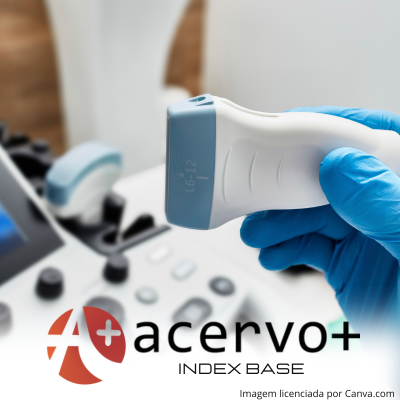Ultrassonografia como ferramenta essencial no acesso venoso central e em pacientes críticos
##plugins.themes.bootstrap3.article.main##
Resumo
Objetivo: Revisar a literatura atual para compreender os benefícios do uso da ultrassonografia na punção venosa central e avaliar suas implicações clínicas e econômicas. Métodos: Trata-se de um estudo de revisão de literatura, do tipo descritivo, que visa analisar o impacto do ultrassom na realização do AVC. Consistiu na seleção de artigos publicados entre 2016 e 2024, disponíveis em bases de dados como MEDLINE, SciELO e LILACS. Foram incluídos artigos em português e inglês que abordassem a eficácia e segurança da técnica ultrassonográfica no AVC, excluindo-se cartas, teses e resumos de congressos. A análise estatística não se aplica por se tratar de uma revisão narrativa. Resultados: Os resultados serão avaliados por meio da análise qualitativa dos estudos selecionados, considerando a taxa de sucesso da punção, tempo do procedimento e redução de complicações pelo aumento da segurança e da eficácia do procedimento com US, além da redução de custos hospitalares associados a complicações evitáveis. Considerações finais: A revisão permitirá uma visão abrangente da efetividade do ultrassom no acesso venoso central e poderá embasar diretrizes clínicas e treinamentos futuros.
##plugins.themes.bootstrap3.article.details##
Copyright © | Todos os direitos reservados.
A revista detém os direitos autorais exclusivos de publicação deste artigo nos termos da lei 9610/98.
Reprodução parcial
É livre o uso de partes do texto, figuras e questionário do artigo, sendo obrigatória a citação dos autores e revista.
Reprodução total
É expressamente proibida, devendo ser autorizada pela revista.
Referências
2. BERTOGLIO S, et al. “A multicenter retrospective study on 4480 implanted PICC-ports: A GAVeCeLT project.” The journal of vascular access, 2022.
3. BODENHAM CHAIR A, et al. Association. of Anaesthetists of Great Britain and Ireland: Safe vascular access. Anaesthesia, 2016; 71(5): 573–585.
4. BRULL SJ e PRIELIPP RC. Vascular air embolism: A silent hazard to patient safety. J Crit Care, 2017; 42: 255-263.
5. CESARO S, et al. Uma. abordagem abrangente para a prevenção de complicações centrais do cateter venoso: resultados de 10 anos de vigilância prospectiva em pacientes com hematologia pediátrica. Ann Hematol, 2016; 95(9): 817-825.
6. DIXON OGB, et al. “A systematic review of management of inadvertent arterial injury during central venous catheterisation.” The journal of vascular access, 2017; 18(2).
7. FERREIRA VP, et al. Cateterismo venoso central: revisão integrativa sobre técnicas e complicações no procedimento. Ulakes Journal Of Medicine, 2021; 1(1).
8. FRANCO-SADUD R, et al. Recommendations on the Use of Ultrasound Guidance for Central and Peripheral Vascular Access in Adults: A Position Statement of the Society of Hospital Medicine. Journal of Hospital Medicine, 2019; 14: 1-22.
9. GOZZANI JL, et al. Practical Guide to Fluid Therapy. John Wiley & Sons, 2020.
10. KEHAGIAS E, et al. Central. venous catheters: Which, when and how. Br J Radiol, 2023; 96(9): 11-51.
11. KIM YI, et al. Usefulness. of ultrasonography for the evaluation of catheter misplacement and complications after central venous catheterization. Clinical and Experimental Emergency Medicine, 2018; 5(2): 71–75.
12. LEE YM, et al. “Clinical. impact of early reinsertion of a central venous catheter after catheter removal in patients with catheter-related bloodstream infections.” Infection control and hospital epidemiology, 2021; 42(2): 162-168.
13. LEIBOWITZ A, et al. Ultrasound. Guidance for Central Venous Access: Current Evidence and Clinical Recommendations. J Intensive Care Med, 2020; 35(9): 303-321.
14. MCMENAM R, et al. J Intensivo Soc, 2017; 18: 258-260.
15. MEDLEJ K, et al. Complications. from Administration of vasopressors through peripheral venous catheters: an observational study. J Emerg Med, 2018; 54(9): 47–53.
16. NORITOMI DT, et al. Avaliação. de custo-efetividade da passagem de cateter venoso central guiada por ultrassonografia comparada com a técnica convencional sob perspectiva da fonte pagadora. Revista Brasileira de Terapia Intensiva, 2016; 28(1): 62–69.
17. OCIDENTAL JB. O início do cateterismo cardíaco e o impacto resultante na medicina pulmonar. Am J Physiol Célula pulmonar Mol Physiol, 2017; 313: 651-658.
18. OOM R, et al. Transitioning from anatomic landmarks to ultrasound guided central venous catheterizations: guidelines applied to clinical practice. J Vasc Access, 2017; 18: 328-333.
19. OSTROFF MD, et al. Rapid. Assessment of Vascular Exit Site and Tunneling Options (RAVESTO): A new decision tool in the management of the complex vascular access patients. J VASC ACCESS, 2023; 24(9): 311-317.
20. SAZDOV D, et al. Comparative. Analysis of Ultrasound Guided Central Venous Catheterization Compared to Blind Catheterization. PRILOZI, 2017; 38(2): 107–114.
21. SOTILLO CC, et al. Impacts. of ultrasonography on the immediate complications of central venous catheterization in the medical residency setting. Brazilian Journal of Health Review, 2024; 7(2): 1-18.
22. SPENCER TR e PITTIRUTI M. “Rapid Central Vein Assessment (RaCeVA): A systematic, 20 standardized approach for ultrasound assessment before central venous catheterization.” The Journal of Vascular Access, 2018; 20: 239–249.
23. YU LV, et al. “Peripherally inserted central catheters have a protective role and the effect of fluctuation curve feature in the risk of bloodstream infection compared with central venous catheters: a propensity-adjusted analysis.” BMC infectious diseases, 2022; 22: 1.

